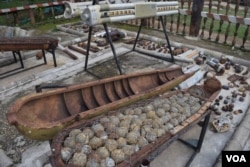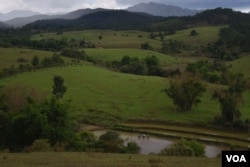The lush green landscape of Laos’ northeastern Xieng Khouang province masks what almost a decade of conflict left behind. Millions of cluster munitions, known in Laos as “bombies,” are scattered among the rice fields and mountains, many buried deep below the surface.
From 1964 to 1973, during the Vietnam War, the U.S. dropped more than two million tons of bombs on Laos. The secret operation was part of an effort to cut North Vietnamese supply lines along the Ho Chi Minh trail, which ran through Laos to the south of Vietnam.
An estimated one third of the 270 million bombies dropped failed to detonate. Their legacy continues to hamper agricultural development in the region, making construction of homes and infrastructure a complex and dangerous proposition, and taking thousands of lives since the war ended.
Tens of thousands of casualties
More than 20,000 people have been killed or injured since the bombing ceased. Some 12,000 people require support for debilitating injuries caused by unexploded ordnance (UXO), almost half of whom are children.
In 2004, in an ethnic Hmong village close to the provincial capital, Phonsavan, Ai Vue lost her son and two nephews when they discovered an unexploded bomb lodged in a tree stump near their home.
“We don’t know if they knocked it or if it just fell and hit the ground and exploded,” she recalls.
“They didn’t know that the bomb was dangerous, because they had never seen one before,” the mother of three said.
UXO education has improved since, which has helped account for a reduction in casualties – from 300 in 2008 to 48 in 2014 – but children playing with the deadly ordnance is still among the most common causes of UXO-related accidents, according to government figures.
Bombs are often unearthed by villagers working in their rice fields, while fires lit above ground have triggered deadly explosions just below. The remains of the war are part of everyday life.
Cleaning up the mess
The government-affiliated UXO Laos is one of a handful of organizations in the country tasked with clearing the bombs. The process is a delicate one that sees clearers scouring the ground inch by inch to uncover the deadly ordnance and detonate those that are unexploded.
“My family worry about my job, but I tell my family not to worry, because I have the training and the experience to clear bombs,” said Kan Thalee, a UXO Laos bomb clearer with over a decade in the job.
With improvements in detection technology, the 12 teams at UXO Laos in Xieng Khouang have improved their productivity, clearing about 600 hectares a year. But it is still a drop in the ocean given the size of the area bombed.
“When you compare that with the needs of the villagers, who ask us to clear the bombs in 5,000 to 6,000 hectares, we can only clear 10 percent,” said Kingphet Phimmavong, the provincial coordinator for UXO Laos.
Less than one percent of the estimated 80 million unexploded cluster munitions across the country has been destroyed since the war ended some 40 years ago.
Kingphet, whose organization is the largest of the mine clearing operations in Laos, says that the Lao government is focused on clearing the land for agricultural development in the region.
“People are living more safely and are have more confidence when they are farming,” he says of the work completed to date.
But he acknowledges that there is still a lot of work to do. Funding for clearance efforts is limited, with much of it coming from international donors.
Technology upgrades and staff increases are needed to hasten clearance efforts, he said.
“We need the organization to grow and bring in more people to work, but we don’t have the budget,” he said.
U.S. contribution
From 1995 to 2015, the U.S. has provided an average of $4.2 million annually to UXO clearance and service provision. This compares to $13.6 million spent per day (in today’s figures) on bombing Laos between 1964 and 1973, according to the advocacy group Legacies of War.
The U.S.-based organization is recommending that the U.S. make a commitment of $25 million per year over the next decade.
“After over 20 years of UXO clearance in Laos, the country is on the cusp of significant developments that could finally make life much safer for Lao villagers,” said Channapha Khamvongsa the founder and executive director of Legacies of War.
“What was once thought to be an insurmountable task now seems achievable in 10 to 20 years rather than a century,” she said in an email. “The next decade is critical, however, and it is necessary for the U.S. to commit to a long-term and sustained level of funding for UXO clearance and victim assistance in Laos.”
Due to meet with Southeast Asian leaders in Vientiane in September, U.S. President Barack Obama will become the first sitting U.S. president to visit Laos.
The U.S. Embassy in Laos confirmed that Obama would announce an increase in funding for UXO programs, although details are yet to be confirmed.
“There are still ongoing discussions about the details of the UXO removal funding increase,” a spokesperson said via email.












